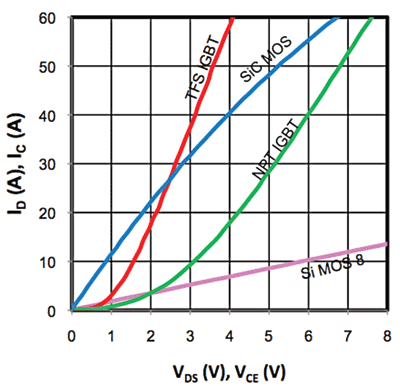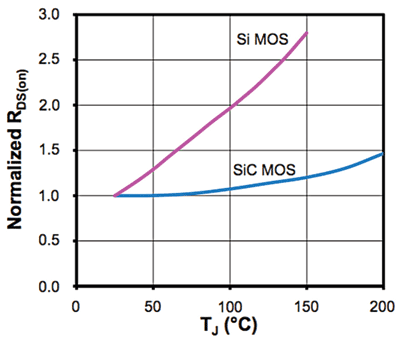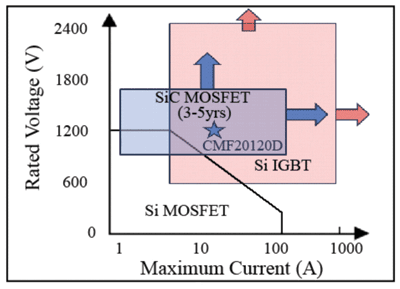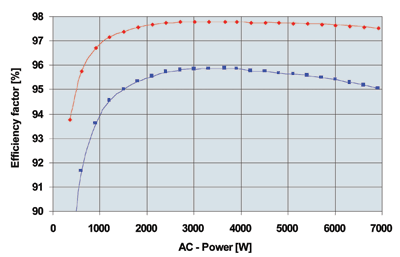The commercialization of SiC technology for switching devices represents a revolutionary change in power electronics
BY BOB CALLANAN, SiC Power Products Applications Manager
Cree
www.cree.com
In power electronics applications, the compound semiconductor silicon carbide (SiC) has been demonstrated in published literature to be a superior material to silicon (Si) in many properties for the construction of power switching devices. With a bandgap that is approximately 3X wider than silicon, SiC devices also exhibit significantly lower leakage current at high-temperature operation by more than two orders of magnitude.
In Figs. 1 and 2 , the forward conduction characteristics of Si MOSFETs, trench field stop (TFS) insulated gate bipolar transistors (IGBTs), non-punch-through (NPT) IGBTs are compared with those of SiC MOSFETs at 25°C and at 150°C.
Tj = 25°C

Tj = 150°C

Figs. 1 and 2: Forward conduction characteristics comparison
As shown in Fig. 3 , the silicon MOSFET’s normalized on-state resistance (RDS(on) ) increases by more than 250% from 25C to 150C, while the RDS(on) of the SiC MOSFET increase just 20% over the same temperature range. The impact of this characteristic on the thermal design of a power electronics system is significant, including the reduction of up to 50% of the thermal management hardware (fans and/or heatsinks).

Fig. 3: Normalized RDS(on) vs. temperature
The SiC MOSFET, as a majority carrier switch, effectively eliminates the minority carrier current “tail” experienced with silicon IGBTs (see Fig. 4 ), resulting in much lower switching losses and facilitates much easier paralleling of switching devices.

Fig. 4: Switching loss vs. temperature comparison (VDD = VCC = 800 V, ID = IC = 20 A, RG = 10 Ω)
At the 1,200-V rating, SiC MOSFETs may be specified in virtually any application that currently employs 1,200-V silicon IGBTs, especially for those applications requiring higher operating frequency and higher system efficiencies. Figure 5 graphically depicts the application area for SiC MOSFETs vs. silicon IGBTs, including solar power inverters, wind turbine inverters, motor drives, induction heating systems, as well as high-voltage dc/dc converters.

Fig. 5: SiC MOSFET application areas
There are two design characteristics that must be observed when applying SiC MOSFETs in a power electronics circuit — the elimination of the ‘turn-off tail current’ exhibited by silicon IGBTs; and a modest transconductance that needs to be factored into the gate drive circuit design.
Although the elimination of the tail current is a significant advantage of the SiC MOSFET over the silicon IGBT, it is also critical to take into account that the IGBT’s tail current does have the effect of dampening parasitics during turn-off. It is vital to design sufficient snubber circuits to manage output interconnection parasitics and prevent the ringing from reaching damaging levels.
Compensating for the modest transconductance in the SiC MOSFET requires that gate-source voltage (VGS ) must be 20 V to ensure optimal performance from the device. This transconductance characteristic can also impact the transition between where the MOSFET operates as a voltage-controlled resistance device to where it becomes a voltage-controlled current source, as a function of VDS . This transition will typically occur at higher VDS values than with conventional silicon MOSFETs or IGBTs.
The transconductance effect must also be considered in the gate drive circuit design, most notably in the requirement that the gate driver be capable of voltage swing of 22 V or higher (for example, a recommended on-state VGS of +20 V, with an off-state VGS of 2 V or -5 V).
Careful consideration must be given to controlling the fidelity of the gate drive pulse, requiring a nominal threshold voltage of 2.3 V when the device is not fully on (dVDS /dt ≈ 0), until gate-source voltage reaches 16 V or higher. The first-order gate circuit is approximated in Fig. 6 , depicting a voltage pulse driving a simple series RLC circuit.

Fig. 6: First-order analysis of gate drive circuit
By minimizing LLOOP , the value of RLOOP necessary for critical dampening can be minimized, along with the rise/fall time of the circuit. This can be best accomplished by ensuring that the gate drive is located as closely as possible to the SiC MOSFET.
To illustrate the advantages of SiC MOSFETs in power electronics, consider the following solar power inverter application. The B6 topology employs a split-link dc-capacitor with the neutral conductor of each capacitor connected at the center point, with the unit connected to a 400-V grid. The 1,200-V silicon IGBTs originally designed into the system were directly replaced with 1,200-V SiC MOSFETs, without any optimization of the drive circuit. As shown in Fig. 7 , the result was a dramatic increase in system efficiency.

Fig. 7: Comparison of three-phase PV inverter efficiency
Replacement of the silicon IGBTs with SiC MOSFETs achieved the system’s maximum efficiency by 1.92% and boosted the overall European efficiency rating by 2.36%, translating into a 50% reduction in overall system losses and a reduction in heatsink temperature by 43°C. Allowing the three-phase grid-connected system to achieve a 99% maximum rating.
To demonstrate the potential for SiC MOSFETs in motor drive applications, engineers at Cree performed an experiment by substituting SiC MOSFETs for the original silicon IGBTs in a 230 Vac, 2-kW three-phase motor drive operating at 16 kHz. The SiC MOSFETs produced a 2% overall efficiency improvement and a 50% reduction in heatsink temperature, enabling a significant reduction and/or simplification of thermal management systems, such as fans. In addition, the ability to operate at higher frequencies (48 kHz and higher), allowed for dramatically reducing the size and weight of magnetic components such as EMI filters and inductors.
For applications in three-phase 480-V power factor correction circuits requiring 1,200-V switching devices, SiC MOSFETs are expected to find wide application. At these voltages, traditional silicon MOSFETs have excessive conduction losses, and silicon IGBTs exhibit significantly higher switching losses, thus putting a limit on their operating frequency. The SiC MOSFETs, however, exhibit both low switching losses and low conduction losses, making them ideal for these types of applications.
High-voltage industrial equipment, including plasma cutters and welders will also be prime applications for the 1,200-V SiC MOSFET. By using the SiC MOSFETs, a 10-kW, 1-kV dc/dc converter operating at 32 kHz has been demonstrated with an efficiency of more than 97%.
The commercialization of SiC technology for switching devices represents a revolutionary change in the field of power electronics. Beyond the device costs, the following system considerations need to be evaluated for a true picture of the potential cost savings:
1. Passive component reduction . Because of their relative numbers, passive power components often comprise the majority of the overall bill of materials costs in a power electronics application. By increasing the operating frequency, both the number of these components (and their corresponding size and cost) can be reduced.
2. Cooling requirement reduction . By reducing heatsink temperatures by more than 50% (as demonstrated by experiments presented in this article), the adoption of SiC technology has the potential to significantly reduce the size and number of heatsinks, as well as a reduction or elimination of cooling fans.
3. Energy-cost reduction over the equipment lifecycle . Looking beyond the simple component costs and manufacturing expenses of a system, the true value proposition of SiC technology comes only if the overall energy savings over the lifecycle of the equipment is considered; and in some cases can be the majority of the savings potential. In systems such as a solar inverter, where cost savings are directly dependent on inverter technology, the elimination of 40% to 50% of switching losses can be the determining factor in the adoption of SiC technology. ■
Advertisement
Learn more about Cree





